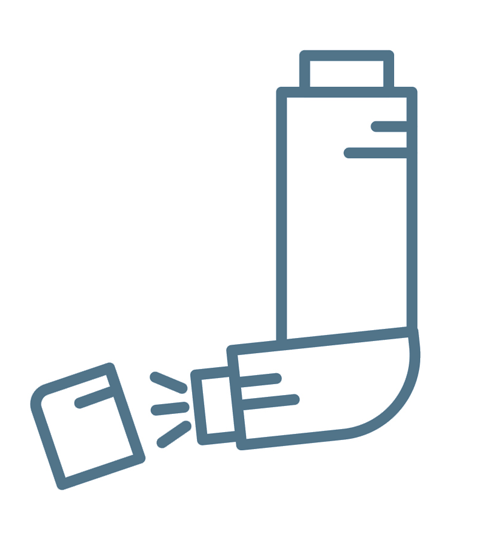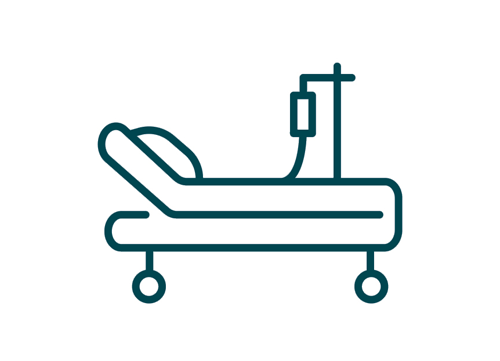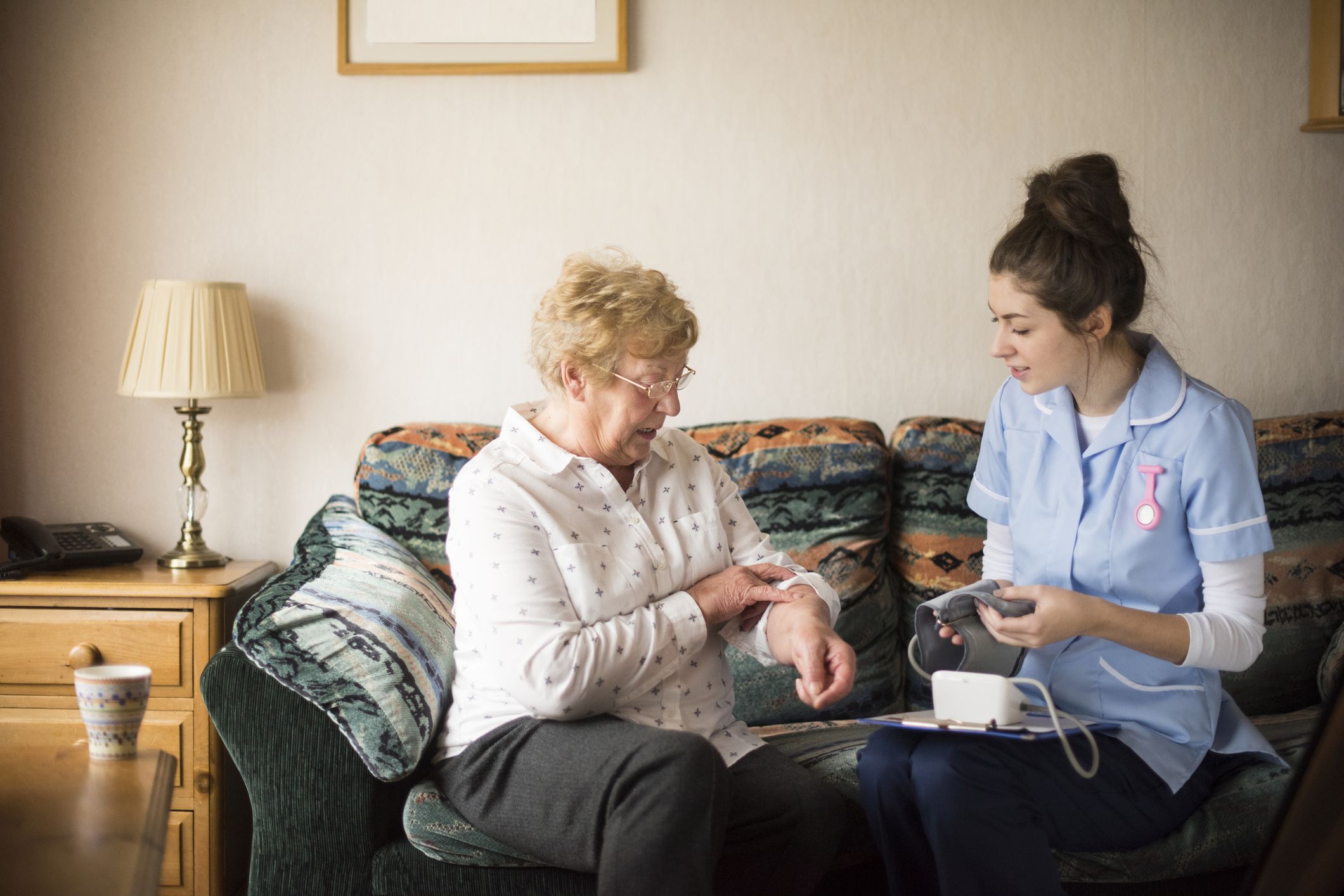Respiratory conditions: reducing pressure on emergency hospital services
By improving prevention, diagnosis and management

An overview of the problem
About 1 in 5 people in the UK have a long term respiratory illness. Half of them are currently being treated. Inhalers are the main treatment used.
Lung diseases result in:
- 6 million inpatient bed days
- more than 700,000 hospital admissions in the UK each year.

To reduce pressure on emergency hospital services, the NHS Long Term Plan prioritises:
- improving prevention
- the diagnosis and management of respiratory conditions.
Using local data
Use data on what's happening locally to assess your current standard of care, and improve it. For example:
- NHS RightCare's ‘where to look’ packs include headline opportunities, improvement opportunity tables and pathways on a page showing how CCGs in your area differ from your peers.
- Public Health England's (PHE) Inhale (an interactive health atlas of lung conditions in England) helps you to compare care across different clinical commissioning groups (CCGs) and regions. For example, you can compare asthma and chronic obstructive pulmonary disease (COPD) care.
Key reports and resources
NICE impact report on respiratory conditions
This report highlights progress made by the health and care system in implementing NICE guidance on respiratory conditions before the COVID-19 pandemic, and highlights where new COVID-19 resources have been developed to help the NHS and social care take action.
The battle for breath: the economic burden of lung disease
A British Lung Foundation resource for policy makers and healthcare providers.
A national 5 year plan for lung health
The Taskforce for Lung Health’s 5 year plan highlights the patient perspective.
The 2nd Atlas of variation in risk factors and healthcare for respiratory disease
Respiratory futures
A collection of resources to support implementing the Long Term Plan actions on respiratory diseases. This includes maps with data for each ICS, case studies and interviews to share best practice.

Improving respiratory health
In this video, Dr Martin Allen, consultant physician in respiratory health, discusses:
- the long term plan emphasis on improved respiratory care
- how we can reduce unnecessary hospital admissions, particularly over the winter months
- addressing the mental wellbeing of people with long term respiratory conditions.

Prevention

Rates of respiratory disease are higher in disadvantaged groups and areas of social deprivation. This is due to factors such as:
- the amount of people who smoke
- air pollution
- poor housing.


Smoking
Smoking still accounts for more years of life lost than any other modifiable risk factor.
To make the case for action, you can:
- Check data on your area from Public Health England’s local tobacco control profiles.
- Read the Royal College of Physicians’ report on the costs and harms of smoking.

You can find all our guidance, advice and other products about stopping smoking on our smoking and tobacco topic page.
Other resources include:
- Our QoF and CCG indicators on smoking.
- National Centre for Smoking Cessation and Training's routes to quit, which gives a model to encourage smokers to access an evidence-based form of support.
- Creating healthy workplaces: toolkit for the NHS, which contains practical tips and step-by-step information from NHS Employers on implementing NICE workplace guidance on smoking and workplace interventions.
- Case studies showing how organisations have used our guidance and standards to improve the quality of services in their areas.
Flu
Flu can cause severe illness or death. This is more likely in older adults and people living with certain chronic medical conditions.
The flu vaccine is the first and most important step in prevention.
Useful reports from Public Health England:
- seasonal flu vaccine uptake in GP patients: winter 2020 to 2021
- weekly national flu reports: 2019 to 2020 season.

All our guidance, advice and other products about flu are on our influenza topic page.
Our flu vaccination guideline makes recommendations on:
- increasing awareness of the flu jab
- using all opportunities to identify people who should be encouraged to have the vaccination.
Our clinical knowledge summaries offer practical guidance for GPs. They also provide accessible summaries of the evidence. These include:


Air pollution
The health problems resulting from exposure to air pollution impact people who suffer from illness and premature death, our health services and business.
The NHS is a significant contributor to air pollution, as it accounts for 3.5% of all road traffic in England.

Every breath we take: the lifelong impact of air pollution from the Royal College of Physicians and the Royal College of Paediatrics and Child Health examines the impact air pollution has on our nation’s health. It will help you build a case for action.
You can find our guidance, advice and other products about air quality on our environment topic page.
The NICE guideline on air pollution: outdoor air quality and health recommends taking a number of actions in combination, because multiple interventions are likely to act cumulatively to produce significant change. This guideline includes recommendations on planning, clean air zones, speed reduction, walking and cycling.
The NHS Long Term Plan includes a commitment to reduce emissions from public sector vehicle fleets, in line with our quality standard on outdoor air pollution.
Early and accurate diagnosis and treatment

The NHS Long Term Plan identifies exacerbations of respiratory illnesses as one of the factors affecting demand for services, so preventing these is a priority.
Early and accurate diagnosis is essential so that people can start treatment and make changes to their lifestyle as soon as possible.
Chronic obstructive pulmonary disease (COPD)
Around a third of people with COPD are not diagnosed until their first hospital admission for exacerbation. Our guidance will help you with improving early diagnosis and managing exacerbations.
All our guidance, advice and other products about COPD are on our COPD topic page.
Our advice and other information on COPD includes:
- indicators on COPD to measure outcomes that reflect quality of care
- a clinical knowledge summary on managing COPD that covers acute exacerbations
- advice on medicines and devices for COPD.

Asthma
In the UK, 5.4 million people are currently receiving treatment for asthma. It is the most common reason for urgent admissions to hospital in children and young people in England.
About 90% of NHS spending on asthma is for medication. But incorrect use of medication can contribute to poorer outcomes and increased risk of exacerbations or admission.

Useful data sources for asthma:
- The Royal College of Physicians’ National Asthma and COPD Audit Programme reports continuous audits of admissions to hospital for adults with asthma and COPD, and includes data for local footprints and individual hospitals.
- The Royal College of Physicians’ national review of asthma deaths identifies avoidable factors and makes recommendations to improve care and reduce the number of deaths.
You can find all our guidance, advice and other products about asthma on our asthma topic page.
Other resources include:
- indicators relating to asthma
- a clinical knowledge summary on asthma, which covers managing asthma, including dealing with exacerbations.


Pneumonia
Community acquired pneumonia is a leading cause of admission to hospital. It continues to place a huge burden on the NHS.
Pneumonia admissions have risen by 35% since 2013, and there are indications that admission may not have always been essential.

You can find all our guidance, advice and other products about pneumonia on our pneumonia topic page.
Another resource includes a clinical knowledge summary on immunizations – pneumococcal.
Tuberculosis
Tuberculosis is curable and preventable. However, if not treated properly, it can be fatal.
You can find all our guidance, advice and other products about tuberculosis on our tuberculosis topic page.

NICE has endorsed these tools produced by other organisations as supporting our guidance: .
CARDMEDIC communication flashcards
Digital flashcards to help healthcare professionals communicate with COVID-19 patients, whilst wearing personal protective equipment such as masks and visors. The tool also includes translations of most content into several languages, which also aids communication.
Breathlessness clinical decision support tool
An algorithm and supporting document to help healthcare professionals remotely triage patients with breathlessness and suspected COVID-19, who have already undergone basic telephone triage to exclude immediate threats to life.
The tool assists triage into 3 groups:
- immediate hospital assessment
- primary care follow-up
- self-care.
It considers red flag symptoms, high-risk and vulnerable groups and other possible causes of breathlessness. It also provides safety netting advice and aids discussion with patients on the advantages and disadvantages of hospital admittance.

Personalised care, behaviour change and mental wellbeing

Ensuring people get the right care, in the right place, at the right time across the health and social care system is key to making the system sustainable and effective.
Expanding the choices and control that people have over their own care is a priority in the NHS Long Term Plan.
The NHS is introducing a comprehensive model of personalised care across England. It covers:
- shared decision making
- enabling choice
- personalised care and support planning
- social prescribing and community-based support
- supported self-management.
Supporting people to change their behaviour and supporting mental wellbeing are also central to managing long term conditions.

Personalised care
We have several products that can help with embedding personalised care into your services:
- The resource on improving transfer of care covers ensuring that people have the support they need when discharged from hospital, for example after an exacerbation of their condition.
- Our quick guide on moving between hospital and home (including care homes) is an easy to read summary for registered managers, which emphasises the importance of good communication, integrated services and discharge planning principles.
- The NICE guideline on older people with social care needs and multiple long-term conditions covers planning and delivering social care and support. It promotes an integrated and person-centred approach to delivering effective health and social care services.
- The NICE guideline on multimorbidity: clinical assessment and management includes recommendations on delivering an approach to care that takes account of multimorbidity. Many people with respiratory conditions also have other long term conditions.

Behaviour change
Helping people to change their behaviour, for example by stopping smoking or being more physically active, can have a big impact on their health.
We have a lot of guidance and other information on this, which you can find on the behaviour change topic page.
Or you can read the resource on Making Every Contact Count to see how our guidance contributes to helping people make changes and lead a healthy life.

Supporting mental wellbeing
Two thirds of people with a long term physical health condition also have a mental health condition. Anxiety and depression are the most common and are a particular issue for people with respiratory conditions.
As set out in Implementing the Five Year Forward View for Mental Health the expansion of Improving Access to Psychological Therapies (IAPT) services aimed to focus on people in these groups:
- providing psychological therapies in the same place as physical health care services
- integrating psychological therapies into primary or secondary care services (such as those for respiratory conditions).
Psychological therapies that are already used in IAPT services could be deployed in IAPT services for people with long term conditions.

Our guidance on mental wellbeing
Our guidance and advice on mental wellbeing that’s particularly relevant to people with multiple long term conditions includes:
Guidance
- The NICE guideline on depression in adults with a chronic physical health problem has recommendations on managing symptoms of depression at step 3 of treatment.
- Some NICE guidelines on individual long term conditions include recommendations on mental wellbeing. An example is the NICE guideline on chronic obstructive pulmonary disease. The section on managing stable COPD has recommendations on pulmonary rehabilitation, multidisciplinary management (including managing depression and anxiety) and self-management (helping to manage anxiety for people who experience frightening breathlessness).
Quality standards
- Depression in adults, which has statements on managing depression in adults with a chronic physical health condition.
- Social care for older people with multiple long term conditions, which has a statement on including physical and mental health needs in a care and support needs assessment.
Social prescribing assessment tool
We've endorsed a social prescribing assessment tool, to help put our guidance into practice. It is a questionnaire for healthcare professionals to use with older patients to give a baseline wellbeing score, before working with them to improve their independence and mental wellbeing.
Case studies
Case studies showing how organisations have implemented guidance on mental wellbeing in people with long term conditions include:
- screening for depression in older adults with chronic physical health problems
- promoting domiciliary self-management of acute COPD exacerbations: improving quality of life and reducing hospital admissions through better symptom control
- transforming mental health care for children and young people with long-term conditions: mental health and psychological wellbeing drop-in centre.
See our topic pages on depression and anxiety (which includes panic disorder) for links to all our guidance and advice on these conditions.

Winter pressures

Respiratory conditions make a big contribution to the pressures on the NHS during winter, because they often lead to people needing hospital care or emergency admission. Reducing these pressures depends on better prevention, diagnosis and management of respiratory conditions, and factors that contribute to these conditions, such as frailty and cold homes.
For every degree drop in temperature below 5°C, primary care respiratory consultations increase by more than 10%, and admissions for respiratory conditions also increase.
Public Health England produces weekly bulletins on emergency department use covering the numbers of people attending and the main types of symptoms they have.

Frailty
Older people with frailty are particularly vulnerable over the winter months. Admissions for patients with frailty often relate to long term health problems such as COPD or to an acute infection such as pneumonia.
Our guidance, advice and other products about frailty are on our older people and multiple long term conditions topic pages.
The resource on improving care and support for people with frailty pulls together the key resources related to the topic. It focuses on improving detection, assessment and risk reduction for people with or at risk of developing frailty.

Cold homes
Cold homes are linked to an increased risk of developing a wide range of conditions including asthma and pneumonia, according to Public Health England. Cold temperatures also lower resistance to respiratory infections. Older people are particularly susceptible to the cold.

You can find guidance, advice and other resources about cold homes on our older people topic page.

Implementation support
For implementation support and slide shows to accompany this resource, contact your local NICE field team.
